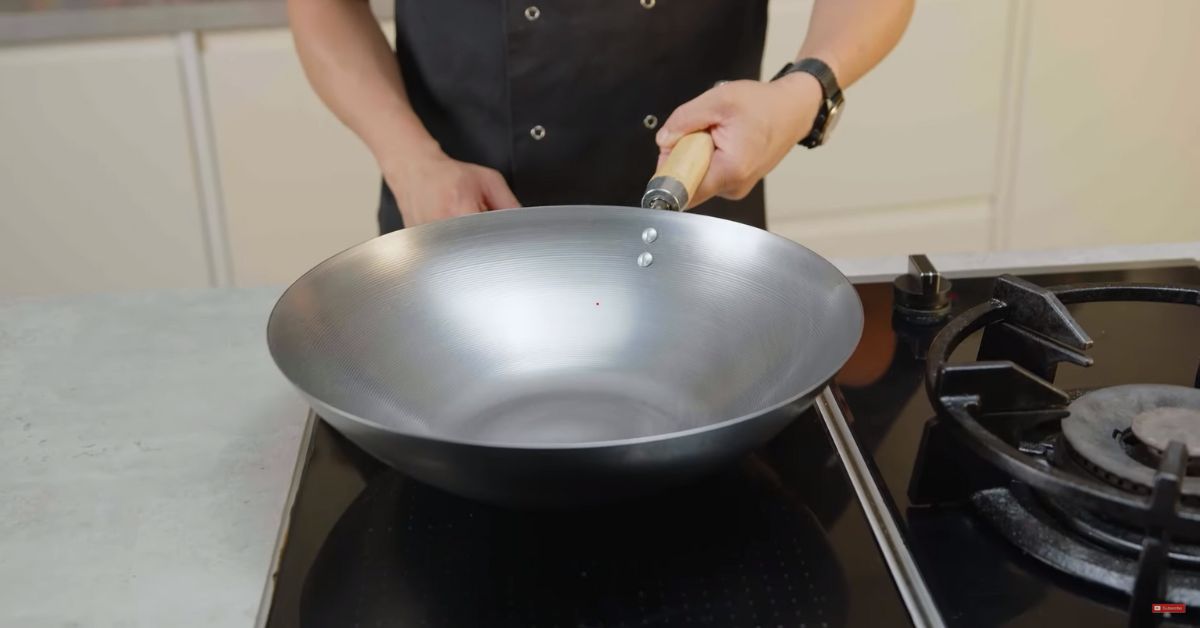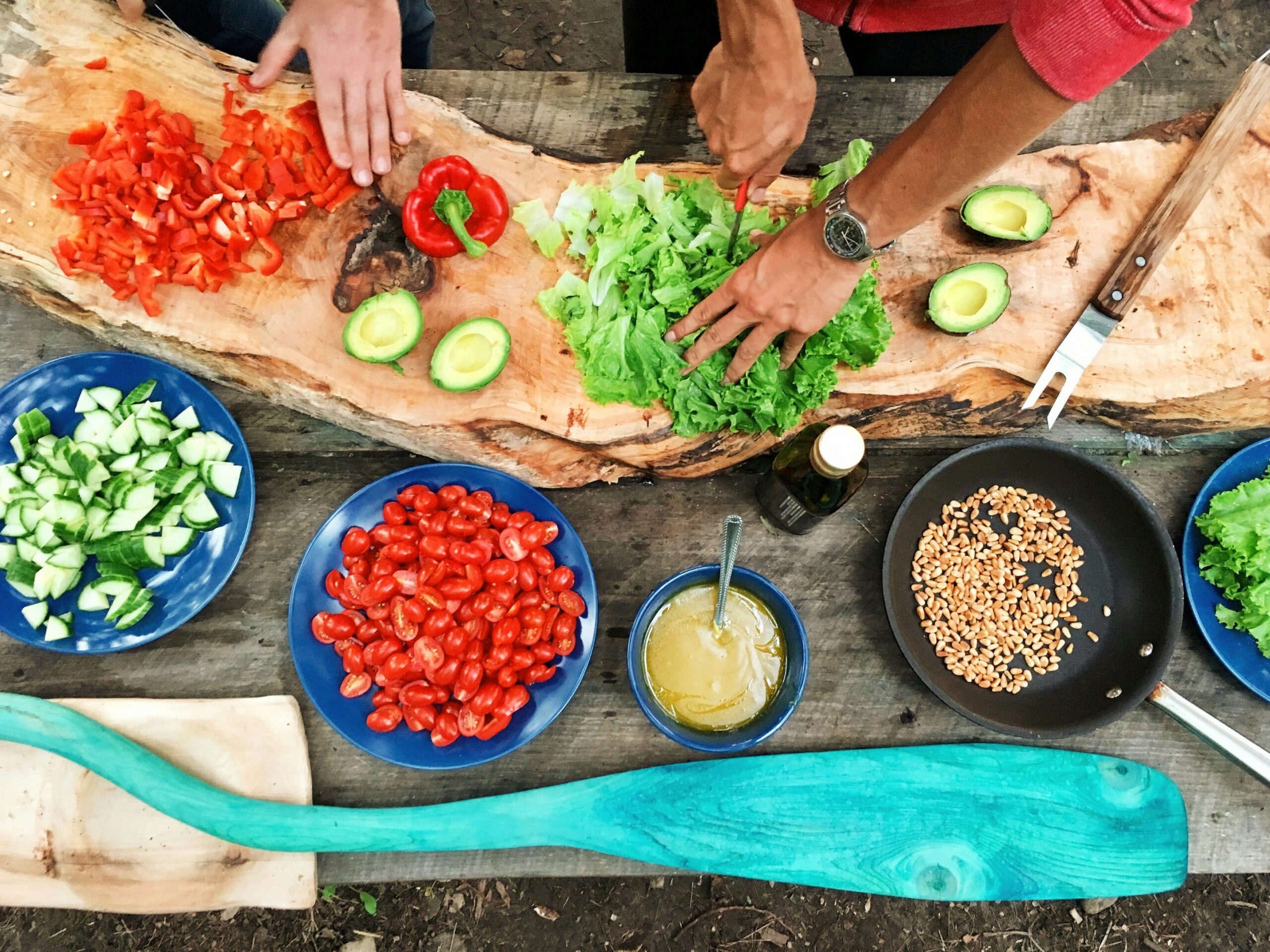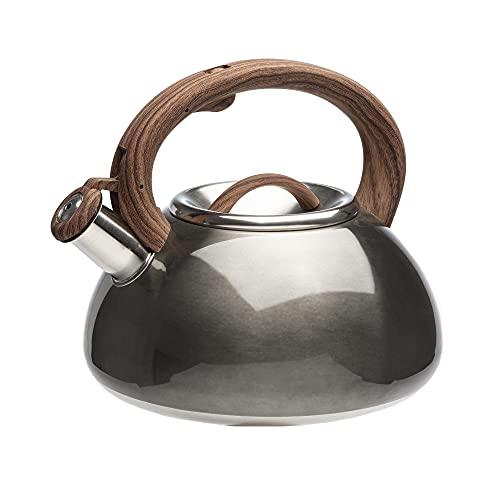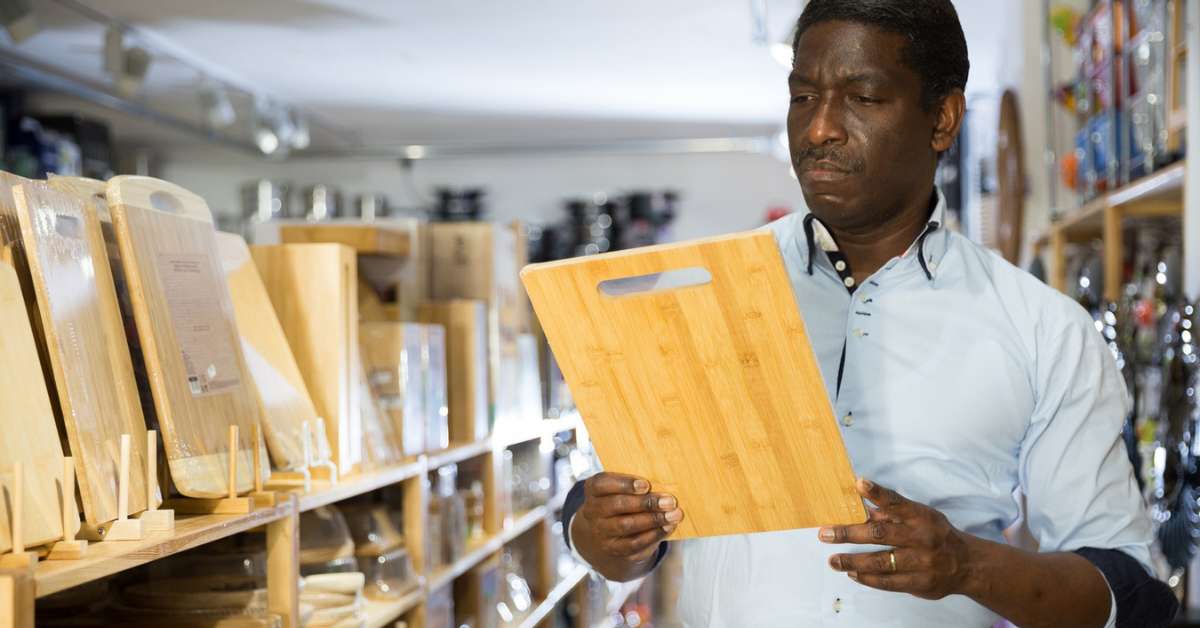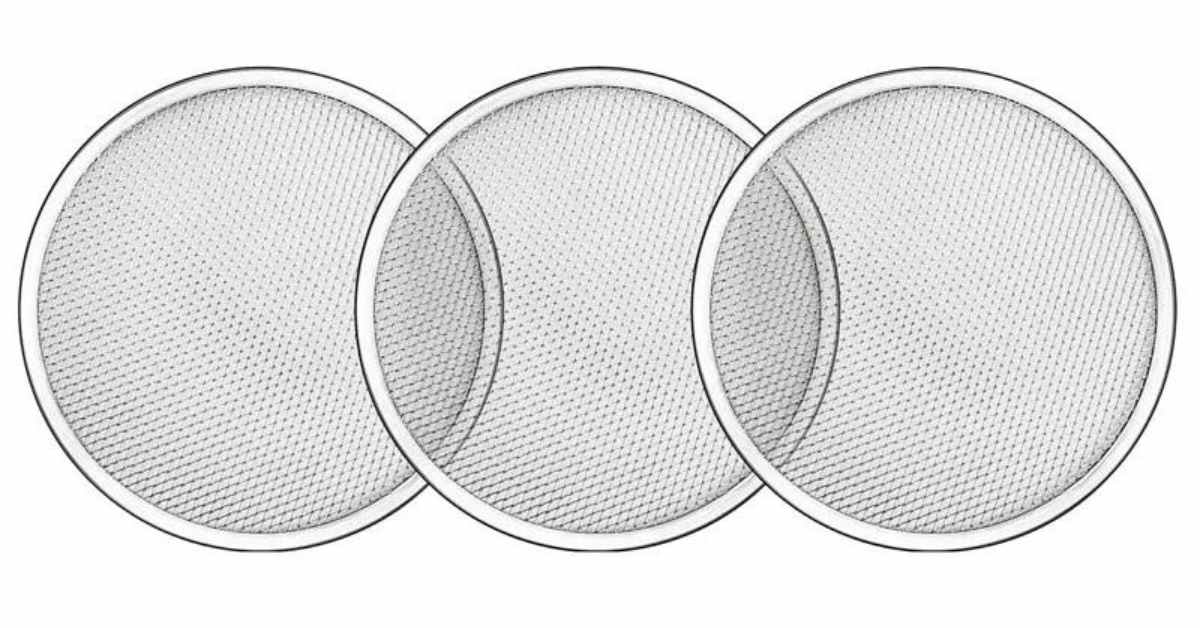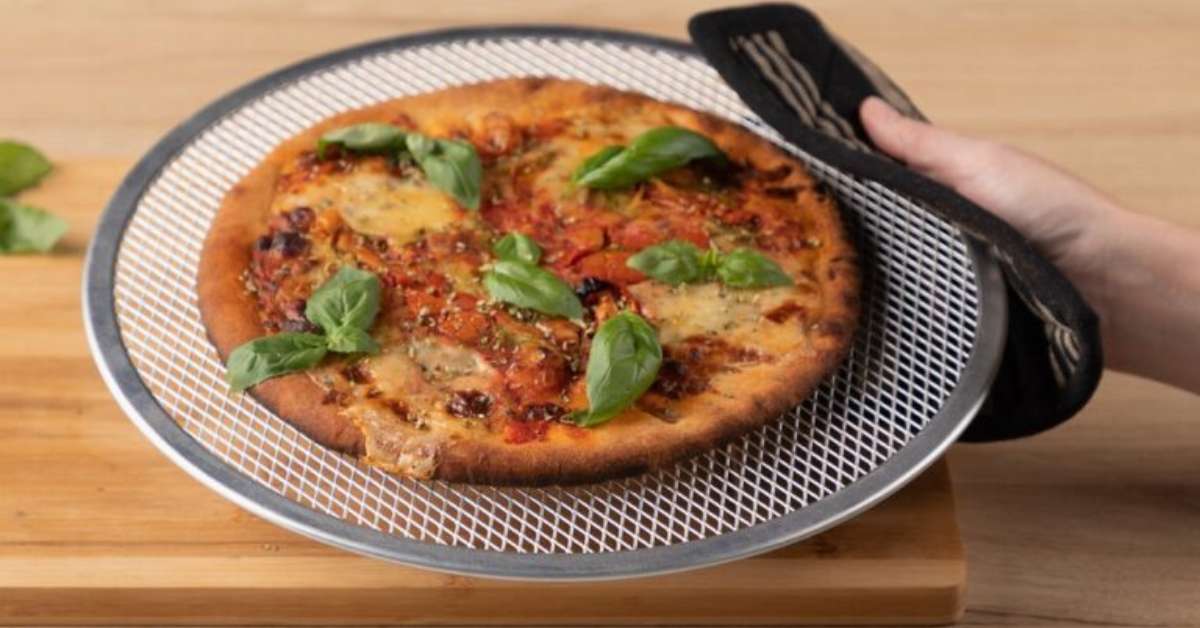Welcome to Foodies Gallery! Today, we’re diving into a common culinary question: “Can You Use a Wok on a Glass Top Stove?” The answer is yes. You can use a wok on a glass gas stove. This is an essential query for all passionate home cooks and aspiring chefs. Glass top stoves have become increasingly popular due to their sleek design and easy cleaning, but they also require careful consideration regarding cookware choices.
In this article, we’ll explore the compatibility of woks with glass top stoves and provide you with valuable insights and tips to ensure a seamless cooking experience. So, if you’ve ever wondered about the perfect stir-fry on your glass-top stove, keep reading, as we’ve got you covered!
Table of Contents
ToggleWhat Is The Glass Top Stove

Before we delve into the compatibility of woks with glass-top stoves, let’s take a moment to understand what a glass-top stove is. A glass top stove, a ceramic cooktop, is a modern and stylish alternative to traditional coil or gas burners.
It features a smooth, flat surface of tempered Glass that houses the heating elements underneath. The sleek appearance adds a touch of elegance to your kitchen and makes cleaning a breeze.
Glass top stoves are favored for their even heating distribution and responsive controls, providing precise cooking temperatures. They offer various heat settings, often including additional features such as timers and safety lock functions.
However, due to their unique construction, they have some specific requirements for cookware selection. Now that we understand glass top stoves better let’s explore whether a wok can be safely used on them.
Compatibility of Woks and Glass Top Stoves
Some essential factors to consider when using a wok on a glass-top stove. The main concern is ensuring that the wok’s material and design are suitable for glass cooktops.
Traditional carbon steel or cast iron woks may not be the best option as they can be rough and may scratch the glass surface. Additionally, their round bottom might not provide adequate stability on a flat cooktop.
However, there are woks specifically designed for glass-top stoves that address these issues. Flat-bottomed woks made from materials like stainless steel or anodized aluminum are better suited for this type of stove. Their flat bases offer stability and ensure maximum contact with the glass surface, promoting efficient heat transfer.
Furthermore, the size of the wok matters. Large woks may not work well on standard-sized glass top stoves as they can cover multiple burners, leading to uneven heating and potential damage to the stove’s surface. Opt for a wok that matches the size of your largest burner for optimal performance.
Always check the manufacturer’s guidelines and recommendations before using any wok on a glass-top stove. Some glass cooktops may have weight limitations for cookware, so adhering to those specifications is crucial to avoid accidents.
Safety Precautions
Using a wok on a glass top stove requires careful attention to safety measures to ensure a smooth and risk-free cooking experience. Here are some essential precautions to follow:
Flat-Bottomed Wok: As mentioned earlier, always use a flat-bottomed wok specifically designed for glass-top stoves. This ensures stability and prevents scratches on the glass surface. Avoid using traditional round-bottomed woks on a flat cooktop.
Size Matters: Choose a wok that matches the size of your largest burner. Using an oversized wok can lead to uneven heating and may exceed the weight limits specified by the stove manufacturer.
Avoid Dragging: When moving the wok on the glass surface, avoid dragging it to prevent scratches. Lift the wok gently when repositioning it on the stove.
Moderate Heat: Glass top stoves heat up quickly, so start cooking on low to medium heat and adjust as needed. High heat is unnecessary for most wok dishes and may damage the wok and the stove.
Cooking Oil: Before adding oil to the wok, make sure the wok is heated first. Adding oil to a cold wok can cause it to pool and create hotspots, potentially damaging the glass surface.
Non-Abrasive Utensils: Use non-abrasive utensils made of wood, silicone, or nylon to avoid scratching the glass surface while cooking.
Cleaning Carefully: After cooking, allow the wok and Glass top stove to cool before cleaning. Use gentle cleaning agents and soft cloths to avoid scratching the Glass.
Avoid Dropping Heavy Objects: Be cautious when handling heavy cookware near the glass-top stove. Dropping heavy objects can cause cracks or damage to the Glass.
Regular Maintenance: Keep the glass top stove clean and free from spills and residue. Regular maintenance will extend the life of both the furnace and the wok.
By following these safety precautions, you can enjoy the benefits of using a wok on your glass-top stove without any worries.
Preparing to Use a Wok on a Glass Top Stove

Using a wok on a glass-top stove requires preparation to ensure a successful cooking experience. Here are the essential steps to get your wok and stove ready:
Cleaning the Wok:
Before you start cooking, it’s crucial to clean the wok thoroughly. New woks often come with a protective coating that needs to be removed. Wash the wok with warm, soapy water and a soft sponge to eliminate manufacturing residues. Rinse it thoroughly and dry it completely before using it for the first time. If you have a seasoned wok, ensure it’s clean from previous cooking sessions.
Preheating the Stove:
Preheating the glass-top stove is an essential step for even cooking. Place the wok on the burner you intend to use and turn on the stove to the desired heat setting. Allow the furnace and the wok to heat up for a few minutes. Preheating will help to ensure that the wok heats evenly and that your ingredients cook properly.
Choosing the Right Oil:
Selecting the right cooking oil is crucial when using a wok. For high-temperature cooking in a wok, oils with a high smoke point are recommended. Examples include peanut oil, canola oil, vegetable oil, and refined safflower oil.
These oils can withstand the heat without burning and producing unwanted flavors. Avoid using oils with low smoke points, like olive oil or butter, as they can create smoke and affect the taste of your dish.
Following these preparation steps, you’ll be ready to use your wok on the glass-top stove. The following section will introduce you to some mouthwatering wok recipes that you can easily prepare on your glass-top stove.
Cooking Techniques for a Wok on a Glass Top Stove
The versatility of a wok allows you to explore various cooking techniques on your glass-top stove. Here are some popular methods that will bring out the best flavors in your dishes:
Stir-frying:
Stir-frying is the most well-known technique for cooking with a wok. The high heat and quick cooking time result in vibrant, crisp vegetables and tender, perfectly seared meat.
To stir-fry on a glass top stove, preheat the wok on medium-high heat, add a small amount of high-smoke-point oil, and toss in your ingredients. Keep them moving constantly with a spatula or wok tool to avoid sticking and ensure even cooking.
Deep-frying:
Deep-frying in a wok is an excellent way to achieve crispy, golden textures. While more common than stir-frying, it’s a fantastic technique for preparing dishes like tempura or crispy spring rolls.
Fill the wok with enough oil to submerge the food and preheat it to the desired temperature for deep-frying on a glass-top stove. A thermometer monitors the oil’s heat and ensures the food cooks evenly.
Steaming:
Steaming is a healthy and gentle cooking method that retains the natural flavors and nutrients of the ingredients. To steam a wok, fill it with a few inches of water, and place a steaming rack or bamboo steamer inside. Bring the water to a simmer, add the food to the steamer, and cover it with a lid. The steam will cook the food to perfection without losing its moisture.
Boiling:
While boiling is not the primary function of a wok, it can be used for preparing soups or boiling noodles. For boiling on a glass top stove, fill the wok with water or broth, and bring it to a boil. Add your ingredients, and cook until they are tender and fully cooked.
Braising:
Braising is a slow-cooking method that involves searing the ingredients and then simmering them in a flavorful liquid. A wok with a tight-fitting lid works well for this technique. Brown the meat and vegetables on medium-high heat, add the juice, cover the wok, and let it simmer until everything is tender and infused with rich flavors.
With these cooking techniques, you can unlock the full potential of your wok on a glass-top stove.
Advantages of Using a Wok on a Glass Top Stove
Using a wok on a glass-top stove offers several advantages that can enhance your cooking experience and the quality of your dishes. Let’s explore these benefits:
Efficiency:
One of the significant advantages of using a wok on a glass top stove is its efficiency in heating. The flat-bottomed wok design allows maximum contact with the glass surface, ensuring an even and quick heat distribution.
This efficiency means the wok heats up faster, reducing the time needed to cook your favorite meals. Additionally, the high, sloping sides of the wok help to contain the heat and distribute it evenly across the ingredients, resulting in perfectly cooked dishes every time.
Health Benefits:
When you cook with a wok, you can enjoy several health benefits. The quick cooking times in a wok, especially when stir-frying, help retain the nutrients in the ingredients, preserving their natural goodness.
Since stir-frying requires minimal oil due to the efficient heat distribution, it can also lead to lighter and healthier meals. Furthermore, using fresh vegetables and lean meats in wok cooking adds to the nutritional value of the dishes, promoting a balanced diet.
Versatility:
A wok’s versatility knows no bounds, and this is further amplified when used on a glass-top stove. From quick stir-fries to slow braises and steaming to deep-frying, a wok allows you to explore various cooking techniques. You can whip up different dishes, from Asian classics to fusion experiments, all in the same cooking vessel. The ability to easily switch between cooking methods makes the wok indispensable.
Eco-Friendly Option:
Using a wok on a glass-top stove can also be considered an eco-friendly choice. Heat distribution and quick cooking times contribute to energy efficiency, as less electricity or gas is consumed during cooking. Additionally, using fresh, locally sourced ingredients in wok cooking supports sustainability and reduces the environmental impact associated with long-distance food transportation.
By embracing the advantages of using a wok on a glass-top stove, you can take your culinary skills to new heights while enjoying the benefits of efficient cooking, nutritious meals, and creative freedom in the kitchen.
Disadvantages of Using a Wok on a Glass Top Stove
While using a wok on a glass-top stove can be a delightful experience, there are some potential drawbacks. Let’s explore the disadvantages:
Compatibility Issues:
One of the primary disadvantages of using a wok on a glass-top stove is the issue of compatibility. Traditional round-bottomed woks, often made of carbon steel or cast iron, are unsuitable for flat glass cooktops.
Their uneven bottoms can cause stability problems and even scratch or damage the glass surface. Investing in a flat-bottomed wok specifically designed for this type of cooktop is essential to use a wok on a glass-top stove.
Safety Concerns:
Safety is paramount when using a wok on a glass-top stove. Glass cooktops are delicate. They can be vulnerable to impact, especially from heavy cookware like a wok. Carelessness in handling the wok or accidentally dropping it on the glass surface can lead to cracks or breakage, which may be costly to repair. Additionally, the high heat required for specific wok cooking techniques, if not properly managed, can result in accidental burns or fires.
Limitations:
Using a wok on a glass-top stove may have some limitations regarding the types of dishes you can prepare. While stir-frying and quick-cooking containers work exceptionally well, other traditional wok cooking methods, such as deep-frying in large quantities of oil, must be more practical on a glass cooktop.
The weight limitations of glass top stoves may also restrict the size of woks you can use, impacting your cooking capacity for larger gatherings.
Special Care Needed:
Glass top stoves require special care and maintenance to avoid scratches, stains, and damage. When using a wok, it’s essential to be extra cautious to prevent any accidental scraping or dragging of the wok on the glass surface. Cleaning the stove and wok after each use with gentle cleaning agents is crucial to maintain the stove’s appearance and performance.
By understanding these potential disadvantages and taking appropriate precautions, you can enjoy the benefits of using a wok on a glass-top stove while mitigating any risks or challenges. As with any cooking equipment, being mindful of the proper usage and safety guidelines will ensure a pleasant and safe cooking experience.
Alternatives to Using a Wok on a Glass Top Stove

Several suitable alternatives exist if using a traditional wok on a glass top stove poses challenges or concerns. Let’s explore these options:
Flat-Bottomed Woks
Flat-bottomed woks are designed for glass-top stoves and offer a great alternative to traditional round-bottomed woks. Their flat base ensures stability on the glass cooktop’s smooth surface.
Flat-bottomed woks come in various materials, such as stainless steel, anodized aluminum, and non-stick coatings. They provide the same versatility and efficiency as traditional woks but with better compatibility for glass top stoves.
Stir-Fry Pans
Stir-fry pans, sauté pans, or skillet woks are excellent alternatives for glass-top stoves. These pans feature a wide, flat cooking surface with gently sloping sides, perfect for stir-frying and sautéing.
They often come with non-stick coatings and ergonomic handles for easy tossing and flipping ingredients. Stir-fry pans provide even heat distribution and are designed to work efficiently on glass-top stoves.
Electric Woks
Electric woks are standalone cooking appliances that can be used on any heat-resistant surface, including glass top stoves. These woks have built-in heating elements, allowing you to control the cooking temperature precisely.
Electric woks are versatile and have various heat settings, making them suitable for multiple cooking techniques beyond stir-frying. They are incredibly convenient for those who want to enjoy wok cooking without a stovetop.
Stovetop Griddles
While not traditional wok alternatives, stovetop griddles can be a creative option for certain wok-style dishes. These large, flat cooking surfaces can be used for searing meats and vegetables, achieving results similar to stir-frying. Griddles provide ample space for cooking multiple ingredients at once and can be an excellent choice for preparing meals for larger groups.
Multi-Purpose Skillets
Many multi-purpose skillets today come with features that mimic wok cooking. They have broad cooking surfaces and high sides, making them suitable for tossing ingredients and quick stir-frying. Look for skillets made of materials compatible with glass top stoves, such as stainless steel or hard-anodized aluminum.
Choosing one of these alternatives can make wok-style cooking accessible and enjoyable on your glass-top stove. Remember to check the compatibility of the cookware with your stove’s guidelines and select options that fit your cooking preferences and needs.
How to Choose the Right Wok for a Glass Top Stove
Selecting the appropriate wok for your glass-top stove is crucial to ensure efficient and safe cooking. Here are some essential factors to consider when making your decision:
Material:
When choosing a wok for a glass-top stove, choose materials compatible with smooth cooktops. Flat-bottomed woks made from stainless steel, hard-anodized aluminum, or non-stick coatings are excellent choices. These materials offer even heat distribution and prevent potential damage to the glass surface. Avoid traditional round-bottomed woks made of carbon steel or cast iron, as they may scratch or destabilize the stove.
Size:
The size of the wok matters, especially on a glass-top stove. Select a wok that matches the size of your largest burner for optimal performance. Using an oversized wok can lead to uneven heating and may exceed the weight limits specified for your stove. A wok with a diameter of around 12 to 14 inches is typically a good fit for most standard glass top stoves.
Shape:
The shape of the wok should also be considered. While flat-bottomed woks are the best choice for glass top stoves, you can further explore the curvature of the sides. Woks with gently sloping sides are more versatile for various cooking techniques, allowing easy stirring and flipping of ingredients. On the other hand, deeper woks are better suited for accommodating larger volumes of food.
Weight:
The weight of the wok is an essential factor to keep in mind, especially when using it on a glass-top stove. While you want a sturdy and durable wok, hefty cookware can be challenging to handle and may increase the risk of accidental damage to the stove’s surface. Look for a wok that balances between being substantial enough to hold its stability and being manageable for everyday use.
Handle and Lid Design:
Consider the design of the wok’s handle and whether it complements your cooking style. Some woks come with long, sturdy handles that provide a comfortable grip, while others may have two small loop handles on either side. Additionally, a well-fitted lid can be advantageous for specific cooking methods, such as steaming or braising.
Considering these factors, you can confidently choose the right wok for your glass-top stove, ensuring enjoyable and efficient cooking experiences with delicious results.
Tips for Using a Wok on a Glass Top Stove
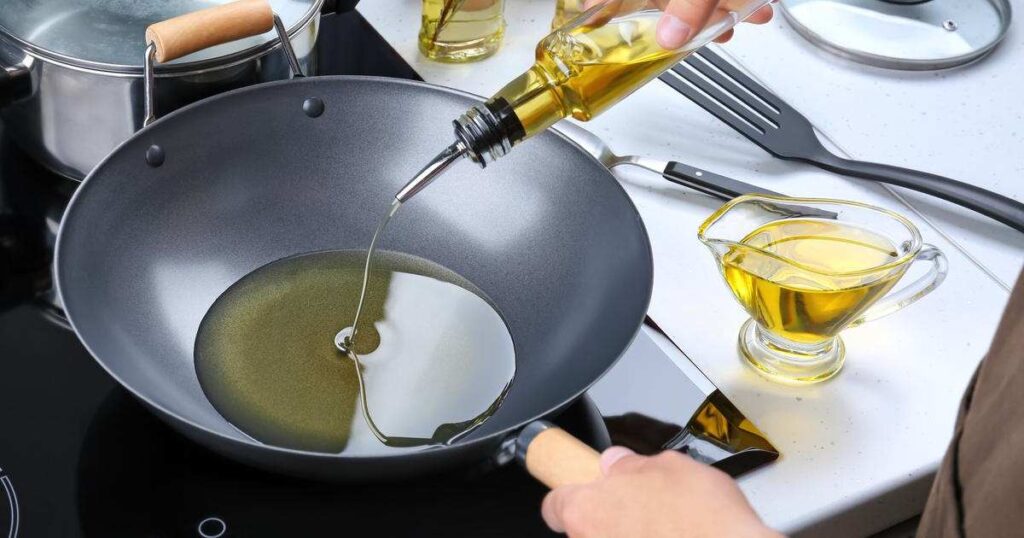
Using a wok on a glass-top stove requires care and attention to ensure optimal results. Here are some valuable tips to keep in mind when cooking with a wok on your glass cooktop:
Don’t Use Too Much Oil: While oil is essential for wok cooking, avoid excessive
amounts. Glass top stoves heat up quickly, and too much fat can lead to splattering and mess. Additionally, abundant oil may cause smoke and unwanted flavors in your dishes. Instead, use just enough oil to coat the ingredients lightly and prevent sticking.
Don’t Overheat the Wok: Glass top stoves efficiently retain heat, so there’s no need to use high heat levels with your wok. Overheating the wok can cause the oil to smoke and burn the ingredients, creating an unpleasant taste. For most wok cooking, medium to medium-high heat is sufficient. Preheat the wok gradually to allow even heating and maintain control over the cooking process.
Use a Lid When Necessary: When cooking certain dishes that require steaming or gentle simmering, consider using a lid to trap the heat and moisture inside the wok. A well-fitted cover will help cook the ingredients evenly and prevent excessive evaporation. However, avoid using a lid for high-heat stir-frying, as it can trap too much moisture and lead to soggy results.
Keep Ingredients Prepped and Ready: Wok cooking is a fast-paced technique, so you must have all your ingredients ready before you start. Once the wok is heated, mix and stir the ingredients quickly, ensuring they cook evenly and retain their vibrant colors and textures.
Maintain a Clean Glass Surface: Before placing the wok on the glass top stove, ensure the surface is clean and free from spills or residue. Any debris or falls can cause uneven heating or even damage the glass surface when exposed to high heat.
Heat-Resistant Utensils: Choose heat-resistant utensils like wooden or silicone spatulas when cooking with a wok on a glass-top stove. These utensils will prevent scratches on the glass surface and allow you to quickly toss and stir the ingredients.
By following these tips, you can make the most of your wok cooking experience on a glass-top stove, confidently creating delicious and healthy meals.
Frequently Asked Questions
What should you not use on a glass-top stove?
There are some types of cookware you should avoid using on a glass-top stove to prevent damage to the glass surface. Avoid using cookware with rough or uneven bottoms, such as traditional round-bottomed woks or cast iron pans, as they can scratch or destabilize the Glass. Glass or ceramic cookware with rough or textured bases should also be avoided. Opt for flat-bottomed cookware made of materials compatible with glass top stoves, such as stainless steel, hard-anodized aluminum, or smooth, flat surfaces.
Can you use any pan on a glass-top stove?
Not all pans are suitable for use on a glass-top stove. To ensure safe and efficient cooking, it’s best to use pans with flat, smooth bottoms that provide even contact with the glass surface. Suitable cookware includes stainless steel, hard-anodized aluminum, copper-bottomed pans, and pans with non-stick coatings. Always check the manufacturer’s recommendations and guidelines for compatibility with glass top stoves before using any cookware.
Can you use a wok on an electric stove top?
Yes, you can use a wok on an electric stove top, including glass top stoves, if you use a flat-bottomed wok designed for this type of cooktop. Flat-bottomed woks made of stainless steel or hard-anodized aluminum work well on electric stovetops. However, avoid using round-bottomed woks on electric stoves, as they may not sit securely on the heating element.
Is using a cast iron frying pan on a glass-top stove safe?
Using a cast iron frying pan on a glass-top stove can be risky. Cast iron is a heavy and rough material that can scratch and damage the glass surface. Additionally, cast iron retains and distributes heat differently than glass cooktops, which may result in uneven heating. If you wish to use cast iron cookware, consider using it on a different type of stove, such as a gas or electric coil.
What kind of cookware do you use for a glass-top stove?
For a glass top stove, it’s best to use cookware with flat, smooth bottoms made of materials compatible with glass cooktops. Suitable options include stainless steel, hard-anodized aluminum, copper-bottomed, and cookware with non-stick coatings. Always check the manufacturer’s recommendations and guidelines for compatibility to ensure safe and efficient cooking on your glass-top stove.
Conclusion
Using a wok on a glass-top stove can be a delightful and rewarding experience if done with care and consideration. Opt for a flat-bottomed wok made of materials compatible with glass cooktops, such as stainless steel or hard-anodized aluminum, to ensure stability and even heat distribution.
Follow safety precautions, including using the right amount of oil, avoiding overheating, and handling the wok carefully. While there are some limitations and alternatives, selecting the appropriate cookware and practicing proper cooking techniques will allow you to explore the vast culinary possibilities a wok offers on your glass-top stove. Happy cooking, and enjoy the flavors of wok-inspired dishes in your kitchen!

